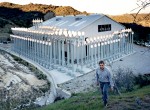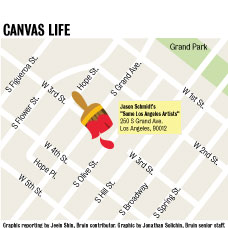You didn’t realize it, but your eyes just took a picture, and they are taking pictures again and again and again as you read word after word after word.
I have to confess that although I’ve always enjoyed art, I was never a huge fan of photography until recently. Something about the ease of taking a picture just didn’t sit right with me, but lately I’ve started to appreciate what the camera can do. After all, photographs capture moments we can never get back. It’s poetic, really.
To go along with my newfound enjoyment for photography, I visited Museum of Contemporary Art’s Grand Avenue location downtown to view the exhibit “Some Los Angeles Artists,” which is running until March 18. Featuring photographs taken by Jason Schmidt, the collection is 23 photographs taken from his larger project called “Artists” which portrays modern artists in various locations relating to their iconic works of art.
By portraying the various artists in locations related to their bodies of work, the photographs conjure whimsical and nostalgic tones that ultimately evoke quiet appreciation for the depicted artists. For instance, the colorful photograph of the late installation artist Jason Rhoades depicts him sitting casually in a cluttered space of neon letters, tangled wires, striped fabrics and long metal poles– all of which were signature items used in his exhibits. Other photos capture much simpler scenes, such as artist Ed Ruscha walking by a gas station, which was a major motif used in his work.
“Some Los Angeles Artists” allows the average viewer to connect a face and name to a contemporary art icon that is widely recognizable. Most artists today enjoy more anonymity than in previous times, when it seemed that more artists, writers and filmmakers were considered big-name celebrities. For example, Andy Warhol and Pablo Picasso were both artists and celebrities of their time, while people like Chris Burden, the artist behind “Urban Light,” the street lamp installation piece in front of LACMA, and Raymond Pettibon, the graphic artist who designed the band Black Flag’s four-bar symbol, are relatively unknown to the general public.
What I especially appreciated about the exhibit was its ability to portray artists as they really are and not who people think they are. By that, I mean the artists appeared to be ordinary people doing what they love as a profession, instead of being seen as pretentious ‘artsy’ individuals. There’s a strong sense of determination in each of these photographs, no matter how silly or random they may seem. These people, these artists, have a point of view they want people to see, just like musicians want their music to be heard or writers want their books to be read.
The exhibit reminded me of my mom at work in her studio, spending months sawing and welding scraps of wood and metal for her next sculpture. Up until now, I thought she did all that work for fun, but now I realize it must have been her passion.
I guess this is all pretty ironic because before I was pretty suspicious about photography, and now after seeing this exhibit, I’m reflecting on things within my own household that I’ve overlooked my entire life. But irony might not even be the best way to describe it. Poetic, maybe.
Email Shin at jshin@media.ucla.edu

